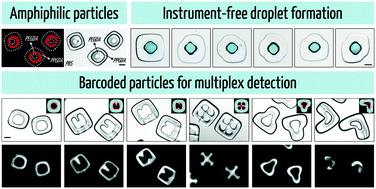Fabrication of 3D concentric amphiphilic microparticles to form uniform nanoliter reaction volumes for amplified affinity assays†
Abstract
Reactions performed in uniform microscale volumes have enabled numerous applications in the analysis of rare entities (e.g. cells and molecules). Here, highly monodisperse aqueous droplets are formed by simply mixing microscale multi-material particles, consisting of concentric hydrophobic outer and hydrophilic inner layers, with oil and water. The particles are manufactured in batch using a 3D printed device to co-flow four concentric streams of polymer precursors which are polymerized with UV light. The cross-sectional shapes of the particles are altered by microfluidic nozzle design in the 3D printed device. Once a particle encapsulates an aqueous volume, each “dropicle” provides uniform compartmentalization and customizable shape-coding for each sample volume to enable multiplexing of uniform reactions in a scalable manner. We implement an enzymatically-amplified immunoassay using the dropicle system, yielding a detection limit of <1 pM with a dynamic range of at least 3 orders of magnitude. Multiplexing using two types of shape-coded particles was demonstrated without cross talk, laying a foundation for democratized single-entity assays.



 Please wait while we load your content...
Please wait while we load your content...